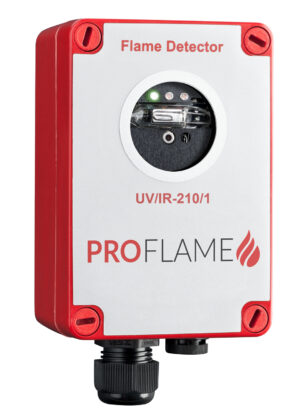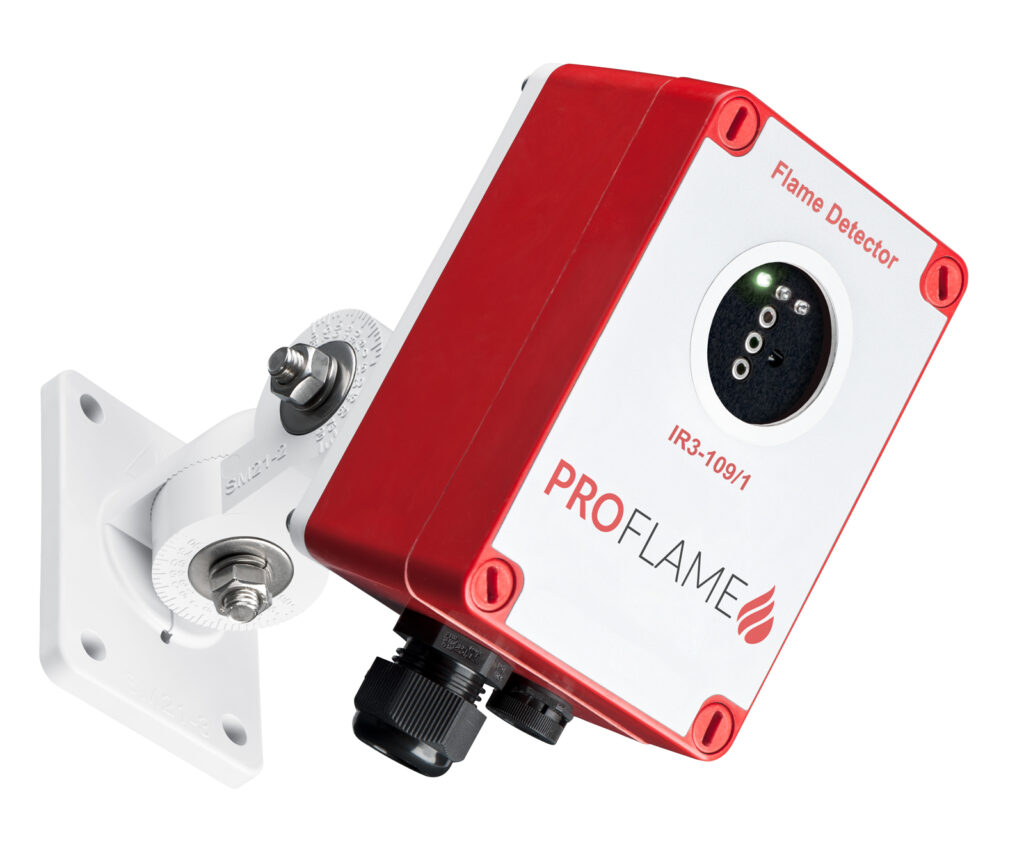
Various Flame Detector Types
Flame detectors are known for their fast response to open fires. Applications vary from indoor to outdoor and from hydrocarbon to non-hydrocarbon fuels. ProFlame offers the best suitable Flame detector types – UV, UV/IR and IR3 – for your plant. A Flame detector self-test is performed every hour to make sure the sensor and electronics operate well. A Test Lamp is available for regular inspections and end-to-end testing.
Why Are There Different Flame Detector Types?
Different types of burning materials emit different types of flames. In order to prevent false alarms (false positives) and avoid non-detection of real fires (false negatives), we have to optimize the sensors for the actual radiation from the possible fires and also keep the price of the Flame detectors as reasonable as possible. This is why we supply three Flame detector types: UV, UV/IR and IR3.
UV Flame Detector
The ProFlame Detector utilises a microprocessor for sophisticated electronic signal analysis. The ultraviolet flame detector is suitable for indoor and outdoor applications. Because of its non-corrosive housing it is suitable for indoor industrial areas were corrosion may play a role. UV (Ultraviolet) energy is emitted by almost every fire; both hydrocarbon and non- hydrocarbon fires. The Ultraviolet Flame Detector will alarm to Arc Welding. To prevent unwanted alarms, for example, electric arcs and or uncovered halogen lamps, the delay time for an alarm is 8-10 seconds. This is sufficient for 90% of the applications. The UV Flame Detector is suitable for applications that include Hydrogen, Radio Amplifier and Antennas but also Heating Rooms for chemicals and Inside Fume hoods in laboratories. A self-test is performed every hour to make sure the sensor and electronics operate well. A Test Lamp is available for regular inspections and end-to-end testing.
UV/IR Flame Detector
The ProFlame Detector is a combination of an Ultraviolet- and Infrared- Flame detector which utilizes a microprocessor for sophisticated electronic signal analysis. The IR part of the flame detector has an additional alarm criterion: the analysis of the flame flicker- frequency. The UV and the IR sensor must both exceed their alarm threshold to initiate a fire alarm. The UV/IR Flame Detector has good false alarms rejection capabilities because the Ultraviolet sensor and the Infrared sensor do not share false alarm sources. The UV/IR Flame Detector can therefore be applied in areas where single UV or IR flame detectors could potentially cause false and/or unwanted alarms. To prevent unwanted alarms, the dynamic delay time for an alarm is 4-8 seconds depending on the size and or the distance to the flames. The UV/IR Flame Detector is suitable for applications that include Hydrogen but in fact, every flame that emits hot water will be detected. A self-test is performed every hour to make sure the sensor and electronics operate well. A Test Lamp is available for regular inspections and end-to-end testing.
IR3 Flame Detector
The ProFlame IR3 flame detectors utilises a microprocessor for sophisticated electronic signal analysis. The Infrared sensors must exceed their alarm threshold balance to initiate a fire alarm. The triple IR flame detector uses an additional alarm criterion: the analysis of the flame flicker-frequency. The infrared IR3 flame detector has good false alarm rejection capabilities, including Arc Welding (> 3m), chopped sunlight or halogen lights but is still able to detect a real fire at the same time. To prevent unwanted alarms, the dynamic delay time for an alarm is 4-8 seconds depending on the size and or the distance to the flames. The triple IR flame detector is suitable for the detection light- and heavy Hydrocarbon fires, in fact, every yellow to red flame that emits Carbondioxide will be detected. A self-test is performed every hour to make sure the sensor and electronics operate well. A Test Lamp is available for regular inspections and end-to-end testing.



